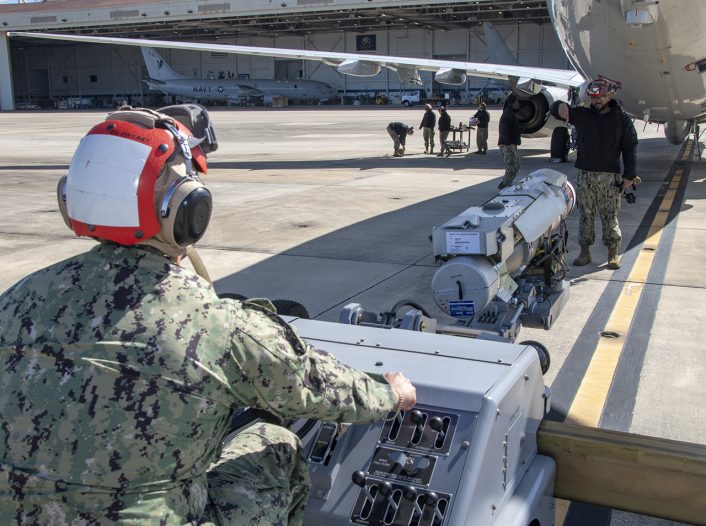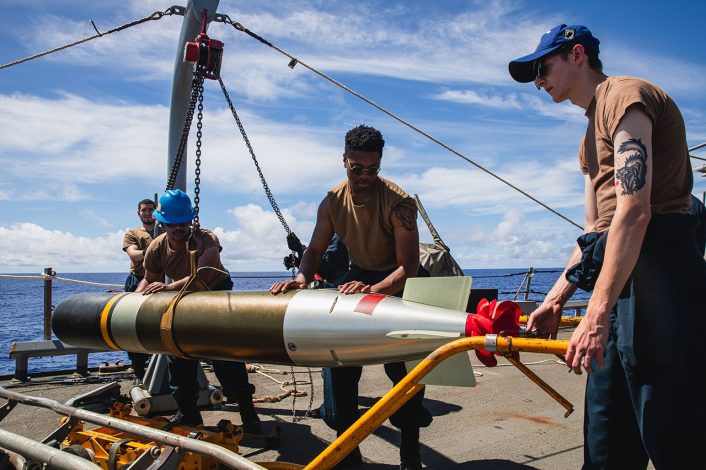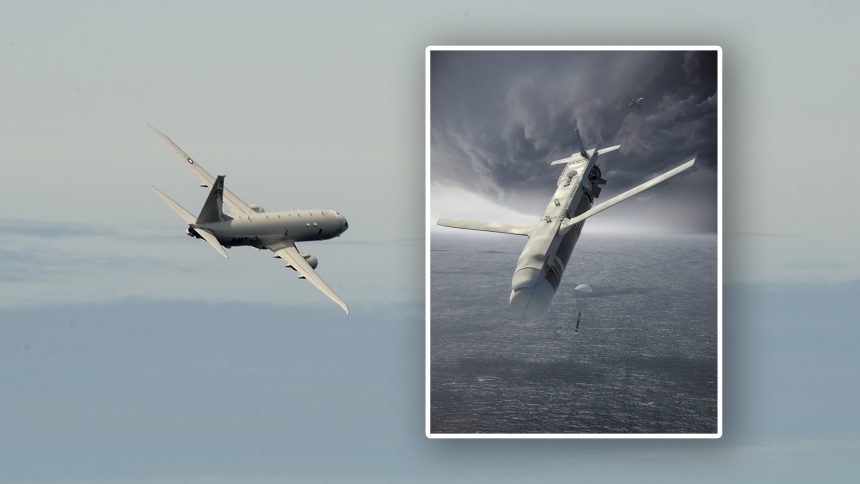A $61m contract awarded to Boeing exercises an option for additional production of High Altitude Anti-Submarine Warfare Weapon Capability kits for Mark 54 torpedoes.
High Altitude Anti-Submarine Warfare Weapon Capability, or HAAWC, adds a deployable wing and guidance system to Mark 54 torpedoes, which allows their deployment from P-8 Poseidon maritime patrol aircraft operating at cruise altitude. The wing allows the weapon to make a controlled descent to the waters’ surface, while additionally offering a boost in engagement range compared to a parachute or high drag tail fins.
Operating at cruise altitude means the P-8 can achieve more efficient performance, lengthening on-station time. It also reduces the likelihood of detection by submarines either using sonar or periscopes. In the longer term, operating at higher altitudes will additionally reduce airframe fatigue.

The wing kit carries the torpedo down to a more conventional release height before levelling off and deploying the torpedo, complete with parachute, in horizontal flight. The system reportedly uses technology previously developed for the Joint Direct Attack Munition (JDAM) bomb guidance kit, as well as the AGM-84H/K Standoff Land Attack Missile-Expanded Response (SLAM-ER) missile.
Initial Operating Capability (IOC) for the HAAWC was declared in 2022, just a few months after being approved for full-rate production. Future upgrades may see the system gain the ability to receive targeting updates via Link 16 after launch.
The majority of contracted work will take place in St. Charles, Missouri, with additional work allocated to Salt Lake City, Utah, St. Louis, Missouri, and other locations. Completion of this contract is expected by January 2028. The number of HAAWC units procured is unspecified.
HAAWC is currently unique to the P-8 Poseidon, though the Mark 54 torpedo is used across the U.S. Navy. There has been some speculation that the kit could be fitted to the RUM-139C Vertical-Launch Anti-Submarine Rocket carried in Mark 41 vertical launch systems, which uses a Mark 54 torpedo as its basis, but this has not yet been developed further.
#Destroyer USS #PINCKNEY DDG91 launching a Vertical Launch ASROC anti-submarine rocket 5 Dec. during a live-fire demonstration in the Pacific. ASROC carries a torpedo that enters the water to hunt submarines. pic.twitter.com/dneyYpurZv
— Chris Cavas (@CavasShips) December 10, 2018
It has also received no export orders, despite a number of other nations operating the Mark 54 and P-8 combination – including the United Kingdom and Australia, both key partners through AUKUS. However, as it is still early in the life of the system, there is still the potential for these orders to come as the capability matures.
Mark 54 Torpedo
The Mark 54 is the U.S. Navy’s newest lightweight torpedo, offering both air-launched and ship-launched capabilities. Submarines are equipped with the much larger Mark 48 torpedo.
Entering service in 2004, the Mark 54 was designed to replace both the Mark 46 and Mark 50 torpedoes with a common design. Both of these types appear to remain in service alongside the Mark 54 for the time being.

The Mark 54 attempts to balance the improved littoral performance of the Mark 50 with the production scale and cost efficiencies of the Mark 46. The current iteration of the weapon is the Mod 1, which reached IOC in 2023.
Initial reports regarding the weapon’s performance prior to the upgrade noted ‘below threshold performance’, which was sustained through multiple assessments over a number of years. It is unclear whether the Mod 1 successfully addressed any of the ongoing issues present with the weapon.
Though it may simply be an indication of a preference for home-grown weapon systems, notably the Royal Air Force is moving towards integrating the Sting Ray torpedo on its P-8 Poseidons in place of the Mark 54.
The Ministry of Defence has confirmed its intent to award a direct procurement contract worth £10.8 million for the integration of the British-made Sting Ray Mod 1 lightweight torpedo onto the Royal Air Force’s Poseidon P-8 maritime patrol aircraft.https://t.co/7NpM563PuM
— UK Defence Journal (@UKDefJournal) May 29, 2025
The UK procured the Mark 54 along with its P-8s to provide a day one capability upon delivery, but announced in 2023 that the Sting Ray used by Royal Navy ships and helicopters would be added as a capability. Germany, another Mark 54 operator, has also expressed interest in procuring the Sting Ray for its P-8 Poseidons, which are due to commence delivery later this year.
A Mark 54 Mod 2 variant is currently in development, though reportedly is not compatible either with the HAAWC kit or the vertical launch adapter. Mod 2 is intended to include a new propulsion system and warhead.









